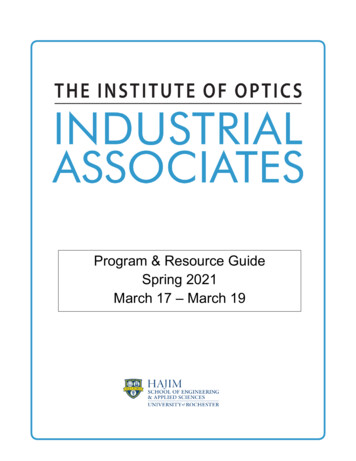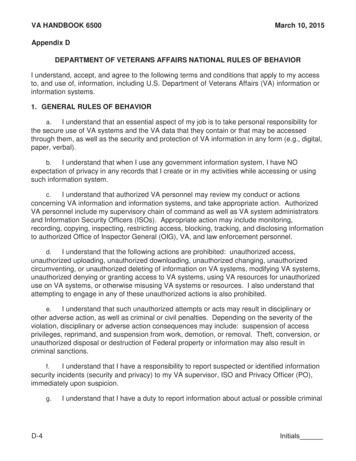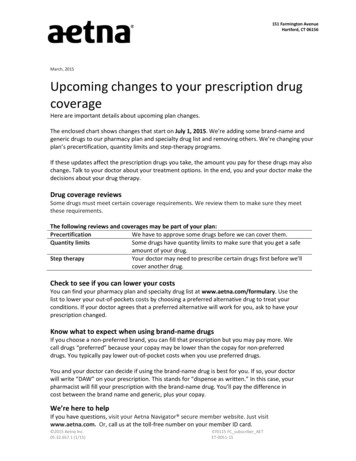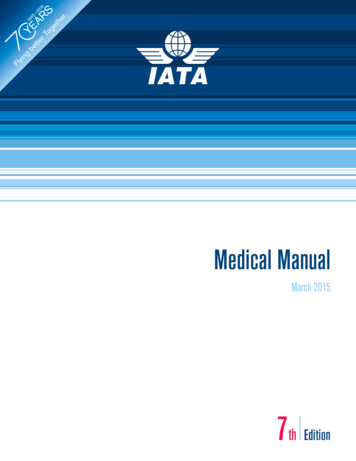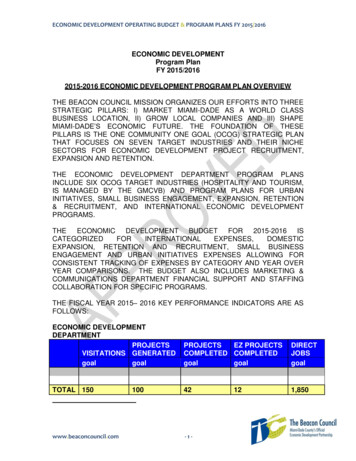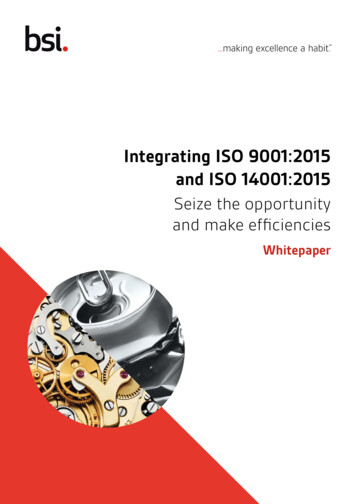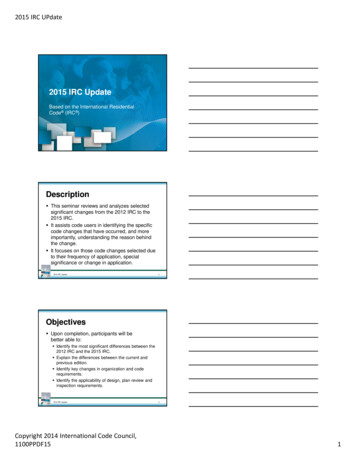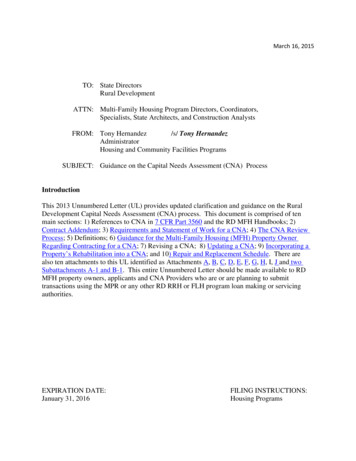
Transcription
March 16, 2015TO: State DirectorsRural DevelopmentATTN: Multi-Family Housing Program Directors, Coordinators,Specialists, State Architects, and Construction AnalystsFROM: Tony Hernandez/s/ Tony HernandezAdministratorHousing and Community Facilities ProgramsSUBJECT: Guidance on the Capital Needs Assessment (CNA) ProcessIntroductionThis 2013 Unnumbered Letter (UL) provides updated clarification and guidance on the RuralDevelopment Capital Needs Assessment (CNA) process. This document is comprised of tenmain sections: 1) References to CNA in 7 CFR Part 3560 and the RD MFH Handbooks; 2)Contract Addendum; 3) Requirements and Statement of Work for a CNA; 4) The CNA ReviewProcess; 5) Definitions; 6) Guidance for the Multi-Family Housing (MFH) Property OwnerRegarding Contracting for a CNA; 7) Revising a CNA; 8) Updating a CNA; 9) Incorporating aProperty’s Rehabilitation into a CNA; and 10) Repair and Replacement Schedule. There arealso ten attachments to this UL identified as Attachments A, B, C, D, E, F, G, H, I, J and twoSubattachments A-1 and B-1. This entire Unnumbered Letter should be made available to RDMFH property owners, applicants and CNA Providers who are or are planning to submittransactions using the MPR or any other RD RRH or FLH program loan making or servicingauthorities.EXPIRATION DATE:January 31, 2016FILING INSTRUCTIONS:Housing Programs
Purpose of the ULThe need for a CNA report arises from numerous property transactions and is intended to recordthe specific physical conditions of each MFH property that is an asset of Rural Development. Aproperly documented report will become the basis for the establishing of a reserve account that isassigned to address the financing for the physical replacement and repair concerns that areprojected to occur for the full duration of the CNA cycle. The report shall include specificphysical property items, systems and components that are not feasibly covered by the yearlymaintenance funds. Although, the listed CNA items can differ from property to property, theoverall intent and goal is to assure that the property is covered financially, in its’ entirety, for allmaintenance, repairs and replacements necessary for suitable living/working conditions for alloccupants/visitors of the property.By following the guidance of this UL there is a higher probability of acceptance of theapplication and a higher probability of successful performance of the property during the CNAcycle. Accuracy of the report and timeliness of the review process are critical to the CNAprocess providing a benefit to the property.1.References to CNA in 7 C.F.R. Part 3560 and the RD MFH HandbooksReferences to a Capital Needs Assessment (CNA) can be found in 7 C.F.R. Part 3560, HB-13560, HB-2-3560, and HB-3-3560; and 7 C.F.R. Part 3565 and HB-1-3565. (See Attachment A,References to Capital Needs Assessment (CNA) in 7 CFR Part 3560 and Handbooks.) Thesereferences include information describing when a CNA is required, suggested uses of a CNA,general requirements for a CNA, sources of funding for a CNA, and situations in which a CNAmay be performed by Rural Development (RD) or other third party provider.2.Contract AddendumRural Development uses a Contract Addendum to supplement the basic CNA agreement or“contract” between the Owner and CNA Provider with additional details and conditions. It canbe found in Attachment B, Addendum to Capital Needs Assessment Contract and mustaccompany all contracts executed between the Owner and CNA Provider for CNAs used in RDtransactions. If any conflicts arise between the “Contract” or “Contract Addendum”, the“Contract Addendum” will supersede.The Contract Addendum identifies the responsibilities and requirements for both the propertyowner and the CNA Provider. To assure proper completion of the contract documents thefollowing key provisions must be completed:a. The Contract Addendum will include the contract base amount for the CNA Provider’scost for services on page B-2, and provisions for additional services to establish the total pricefor the CNA.b. Item I(e) requires an itemized listing for any additional anticipated services and theirunit costs including future updates and revisions that may be required before the CNA isaccepted by RD Note: Any cost for updating a CNA must be included, in the “additionalservices" subpart, of the original CNA contract.II
c. The selection criteria boxes in II a, identify the type of CNA being provided.d. In III (a), the preferred language for the blank on "report format" is: “USDA RD CNATemplate, current RD version, in Microsoft Excel format”. This format will import directly intothe underwriting template for loan underwriting purposes.3.Requirements and Statement of Work for a CNAMinimum requirements for a CNA acceptable to RD can be found in Attachment C, CapitalNeeds Assessment Statement of Work. This is supplemented by Fannie Mae, Appendix D,Reference Effective Useful Life (EUL) Table, Instructions for the Property Evaluator, andAttachment J, Guidance on the Rehabilitation of MFH Properties. To resolve any inconsistencyin the two documents, Attachment C, the CNA SOW will in all cases prevail over theAttachment D, Fannie Mae, Appendix D, Reference Effective Useful Life (EUL) Table,Instructions for the Property Evaluator. Fannie Mae defines the “term” as “term of the mortgageand two years beyond”. For USDA, the “term” will be 20 years, as defined in the CNA SOW.Attachment C includes the required qualifications for the CNA Provider, the required scope ofwork for a CNA assignment, and general distribution and review instructions to the CNAProvider. CNA Providers must be able to report the current physical condition of the propertyand should not base their findings on the financial condition of either the property or the Owner.Attachment D is a three-part document Rural Development uses as reference to the CNA processthroughout the RD revitalization and demonstration program efforts. The three key componentsof this Attachment are: 1) guidance to the property evaluator; 2) expected useful life tables; and3) a set of forms. It includes general instructions used in completing CNA reports, specificinstructions on how to use the expected useful life tables and a set of applicable forms includingthe Terms of Reference form; Systems and Conditions forms; and Evaluator’s Summary forms.An acceptable CNA will appropriately address each of the following supplemental concernswithin the report and narrative:a. Attachment E, Accessibility Laws and Requirements, outlines the federal accessibilitylaws, regulations, and standards that apply to Section 515 and Section 514/516 Multi‐FamilyHousing properties. The CNA Provider should use Attachment E as a guide in assessing howthe property meets the requirements for accessibility to persons with disabilities. The CNAreport should include any actions and estimated costs necessary to correct deficiencies inorder for the property to comply with applicable federal, state, and local laws andrequirements on accessibility. The report should also include an opinion based on theadequacy of a current, approved transition plan for the property or advisory that one wasnot presented for review.III
b. Attachment F, Existing Property Accessibility Checklist, contains general information in achecklist format that indicates a sample of the requirements for compliance that should beverified by the CNA Provider. For example, a transition plan that does not address all of thedeficiencies listed in Attachment F, or is outdated, is not adequate. Attachment F should beused to indicate accessibility compliance corrections necessary to the property. It is theresponsibility of the Provider to inspect and verify whether all accessibility features arecompliant. The checklist is intended as a general guide and NOT intended to cover everyaspect of accessibility (which may vary depending on site location). The Uniform FederalAccessibility Standards (UFAS) paragraph references are bolded and guideline languageitalicized. This Attachment provides relevant information extracted from the UFAS andparaphrased but is not necessarily quoted verbatim.c. Attachment G, Accessibility Requirements for Rural Development Financed Existing Multi‐Family Housing (Supplemental Questions & Answers), provides “Frequently AskedQuestions” on accessibility for RD MFH Program involving the existing MFH properties,which may be helpful to the CNA Provider.d. Attachment J, Attachment J, Guidance on the Rehabilitation of MFH Properties providesguidance on the rehabilitation of Rural Development Multi‐Family Housing (MFH) propertiesusing the Section 515 Rural Rental Housing and Section 514/516 Farm Labor Housingprograms. It provides the primary guidance on the standards and requirements for projectsusing only Agency funding to complete the repairs or rehab. When financing sources include“third party” sources there may be other or additional construction requirements andconditions which will need to be discussed and mutually accepted by all parties involved.With projects using any third party (non‐RD) financing the principles of Attachment J shouldbe applied to the extent necessary to assure the Agency's security interest is adequatelyaddressed.4.The CNA Review ProcessA CNA used by Rural Development will be reviewed by the designated RD CNA Reviewerserving the area. The CNA Reviewer will be an architect, construction analyst, appraiser, orother staff member with education, training, and experience in construction, rehabilitation, andrepair of Multi-Family Housing (MFH) properties, especially as it relates to repair, replacementand maintenance costs throughout the term covered by the CNA.A CNA report must be obtained by the property owner from a third party CNA Provider that hasno identity of interest with the owner, management agent, buyer or any other principle or affiliatedefined in 7 C.F.R. Part 3560, §3560.11. The property owner will contract with the CNAProvider and is therefore the client of the provider. However, the owner should consult withIV
Rural Development before contracting with a CNA Provider to review Guidance for the MFHProperty Owner Regarding Contracting for a CNA shown in this letter as Item 6, and theAddendum to Capital Needs Assessment Contract (Attachment B). The RD CNA Reviewer willevaluate a proposed agreement or engagement letter between the Owner and a CNA Providerusing Attachment H, Capital Needs Assessment Guidance to the Reviewer, prior to reviewingany CNA report. Unacceptable CNA proposals, contracts or reports will be returned to theapplicant for appropriate corrections before they will be used for any underwritingdeterminations.The CNA Reviewer will also review the cost of the CNA contract. The proposed fee for theCNA must be approved as an eligible housing project expense under 7 C.F.R. 3560.103 (c) forthe agreement to be acceptable and paid using project funds. If the CNA is funded by theproperty’s reserve account, a minimum of two bids is required if the CNA service contractamount is estimated to exceed 3,500, in accordance with HB-2-3560, Chapter 4, section 4.17-B.If the contract is funded by another source, or will be under 3,500, a single bid is acceptable.(However, the Agency recommends multiple bids in all cases. There is no Agency requirementto select the “low bidder” and the owner may select a CNA Provider based on qualifications, aswell as price after reviewing references and past work.)If the proposed agreement is acceptable, the reviewer will advise the appropriate RuralDevelopment servicing official, who will in turn, inform the owner. If the proposed agreement isunacceptable, the reviewer advises the owner and the CNA Provider in writing and identifiesactions necessary to make the proposed CNA submission acceptable to Rural Development.Upon receipt of a satisfactory agreement, the RD CNA Reviewer should advise the appropriateRural Development servicing or underwriting official to accept the proposal.The CNA Reviewer will review a preliminary CNA report delivered to Rural Development bythe CNA Provider using Attachment H, Capital Needs Assessment Guidance to the Reviewer,(including the checklist provided) and Attachment I, Sample Capital Needs Assessment ReviewReport, to write the preliminary CNA review report. The preliminary CNA report will bedelivered to the Rural Development loan and servicing official(s) to jointly discuss the findingsand reviewer’s conclusions. If necessary, the loan official will then notify the owner in writingof any revisions that are necessary to make the CNA report acceptable to Rural Development.The CNA Reviewer will review the final corrected CNA report to verify that the report isacceptable to Rural Development before delivering the final CNA review report to the loanofficial for a subsequent joint discussion to verify the report complies with the CNArequirements. Any difference of opinions exist regarding the findings at this time must bemutually addressed by RD staff before the final CNA review report is delivered to the owner. Toconfirm this discussion between the CNA Reviewer and loan official, the final CNA reviewreport must be signed by both the CNA Reviewer and the loan official.V
During the CNA review process, the CNA Reviewer and the underwriter must consult with thefield office most familiar with the property for their input and knowledge of the property. Uponsignature by the RD CNA Reviewer and Loan Underwriter this report becomes the “accepted”CNA indicating the actual condition of the property at the time of the CNA inspection – a“snapshot” in time – and will be marked “Current Property Condition” for indefinite retention inthe borrower case file.5.DefinitionsThe following definitions are provided to clarify terms used in conjunction with the CNAprocess:As-is CNA: This type of CNA is prepared for an existing MFH property and reports thephysical condition of the property based on that moment in time. This CNA can be useful formany program purposes other than the MPR, such as, an ownership transfer, pre-paymentincentive and evaluating or resizing the reserve account. The As-is report will include all majorrepairs and likely some minor repairs that are typically associated with the major work; eachmajor component, system, equipment item, etc. inside and outside; building(s); property; accessand amenities in their present condition . A schedule of those items showing the anticipatedrepair or replacement time frame and the appropriate, associated hard costs for the ensuing 20year term of the CNA serves as the basis or starting point in evaluating the underwriting that willbe necessary to determine the feasibility and future viability of the property to continue servingthe needs of eligible tenants. The As-is CNA is an important tool when a property rehabilitationis anticipated. A well document As-is report will provide an excellent assessment tool when theagency reviews the rehabilitation scope of work.“Post Rehab” CNA: This type of CNA is done for an existing MFH property as well, butconsiders any planned rehab or major repairs proposed for the property transaction. It builds onthe findings of the accepted As-is CNA and is typically prepared for a project that will be fundedfor a major rehabilitation. The Post Rehab CNA is adjusted to reflect the work intended to beperformed during the rehabilitation. The assessment must be developed from the rehabilitationproject plans and any construction contract documents to reflect the full extent of the plannedrehab.Life Cycle Cost Analysis: When a CNA is required prior to beginning the construction ofa new project, then a more suitable process is known as a Life Cycle Cost Analysis (LCCA). AnArchitect or Engineer is the best qualified person(s) to prepare this report. A LCCA is anexpanded version of a CNA and is defined at 7 C.F.R. Section 3560.11. The LCCA willdetermine the initial purchase cost, the operation and maintenance cost, the “estimated usefullife”, and the replacement cost of an item selected for the project. The LCCA provides the ownerwith the CNA information on repair or replacement costs and timeframes over a 20-year period.VI
It also provides information that will assist with a more informed component selection and canprovide the owner with a more complete financial plan based on the predictive maintenanceneeds associated with those components. If the newly constructed project has already beencompleted without any previous CNA requirement, either an “As-is” CNA or LCCA can beprovided to assist in establish the required reserve needs analysis necessary for establishingprogram mandated reserve deposits.Consolidation: In some circumstances, Rural Development may permit two or moreadjoining properties to be consolidated as defined in 7 CFR 3560, §3560.410 when it is in thebest interests of the government. The property owner should consult with the RD loan officialbefore engaging the CNA Provider in any case where the CNA intends to encompass more than asingle (one) existing RD property to determine if a consolidated CNA may be acceptable for RDunderwriting. Rural Development requires that individual properties be identified by name oraddress so the the condition reported is specific to a unit, building or property.Any proposed consolidation of properties or merging of ownership interests in any form,must comply with the specific program authorities and requirements as specified in therespective program regulations and guidance before engaging the CNA provider CNAs, as wellas 504 Self Evaluation/Transition Plans or other accessibility assessments, should be performedindependently for each legal entity receiving federal fundsA CNA Provider should be fully aware of the intended use for the CNA because it can impactthe calculations necessary to perform adequate accessibility assessments and can impact theacceptability of the report by RD. Unacceptable reports will not be used for any RD underwritingpurposes even though they may otherwise be acceptable to the owner or another third partylender or participant in the transaction being proposed.Note: All CNA’s will be required to include all line items relevant to a property when a CNA isperformed. Line items exceeding an EUL of greater than 20 years may or may not include a costat the discretion of the CNA provider, Owner, or Agency Representative.6.Guidance for the MFH Property Owner Regarding Contracting for a CNARural Development Offices in each State Office maintains a directory of CNA Providers, andcan forward that information to the MFH property owner upon request at the time a CNA isbeing proposed. However, the property owner is not required to use a CNA Provider from theRD State directory. Note: Rural Development in no way guarantees the performance of the CNAProviders listed in their respective directories.Property owners are advised to request an information package from several CNA Providers andto evaluate the information before selecting a provider. At a minimum, the information packageshould include a list of qualifications, a list of references, a client list, and a sample CNA reportVII
but the Owner may request any additional information they feel necessary to evaluate potentialcandidates and select a suitable provider for this service. Consideration for the type of CNArequired should be part of the owner’s selection criteria and inserted into the contract language aswell. The necessary skill set to perform the As-is versus the Post Rehab or New ConstructionCNA versions, needs to be considered carefully. Knowledge of the accessibility laws andstandards and the ability to read and understand plans and specifications could also be among thecritical skill elements to consider.Attachment B, Contract Addendum should be submitted to Rural Development with the contract,and signed by Owner and CNA Provider. The proposed agreement with the property
property’s reserve account, a minimum of two bids is required if the CNA service contract amount is estimated to exceed 3,500, in accordance with HB-2-3560, Chapter 4, section 4.17-B. If the contract is funded by another source, or will be under 3,500, a single bid is acceptable. (Howe
